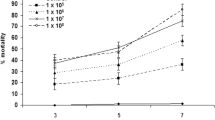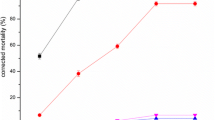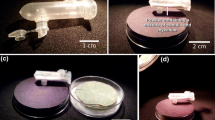Abstract
Entomopathogenic fungi and predatory mites can independently contribute to suppressing the two-spotted spider mite, Tetranychus urticae Koch. It is important to assess the risk of possible fungal infections in predators when a combination of them are being considered as a tandem control strategy for suppressing T. urticae. The first part of this study tested 12 Beauveria bassiana isolates for virulence in T. urticae. Strains SCWJ-2, SDDZ-9, LNSZ-26, GZGY-1-3 and WLMQ-32 were found to be the most potent, causing 37.6–49.5% adult corrected mortality at a concentration of 1 × 107 m/L conidia 4 days post-treatment. The second part evaluated the pathogenicity of these five strains in five species of predatory phytoseiid mites. The bioassay results indicated that all adult predatory mite mortalities ranged from 7.5 to 9.1% 4 days post-treatment. No viable fungal hyphae were found on predator cadavers. Observations with scanning electron microscopy revealed that conidia were attached to the cuticle of predatory mites within 2–12 h after spraying with strain LNSZ-26, and had germinated within 24–36 h. After 48 h, conidia had gradually been shed from the mites, after none of the conidia had penetrated the cuticular surfaces. In contrast, the germinated conidia successfully penetrated the cuticle of T. urticae, and within 60 h the fungus colonized the mite’s body. Our study demonstrated that although several B. bassiana strains displayed a high virulence in T. urticae there was no evident pathogenicity to phytoseiid mites. These findings support the potential use of entomopathogenic fungus in combination with predatory mites in T. urticae control programs.









Similar content being viewed by others
References
Abbott WS (1925) A method of computing the effectiveness of and insecticide. J Econ Entomol 18:265–267
Altre JA, Van Denberg JD, Cantone FA (1999) Pathogenicity of Paecilomyces fumosoroseus isolates to diamondback moth, Plutella xylostella: correlation with spore size, germination speed, and attachment to cuticle. J Invertebr Pathol 73:332–338
Bugeme DM, Knapp M, Boga HI, Wanjoya AK, Maniania NK (2009) Influence of temperature on virulence of fungal isolates of Metarhizium anisopliae and Beauveria bassiana to the two-spotted spider mite Tetranychus urticae. Mycopathologia 167:221–227
Butt TM (1990) Fungal infection process—a mini-review. In: Proceedings and abstracts, Vth international colloquium on invertebrate pathology and microbial control. Adelaide, Australia, pp 121–124
Chandler D, Davidson G, Jacobson RJ (2005) Laboratory and glasshouse evaluation of entomopathogenic fungi against the two-spotted spider mite, Tetranychus urticae (Acari: Tetranychidae), on tomato, Lycopersicon esculentum. Biocontrol Sci Technol 15:37–54
Chang GC (1996) Comparison of single versus multiple species of generalist predators for biological control. Environ Entomol 25:207–212
Choi WI, Lee SG, Park HM, Ahn YJ (2004) Toxicity of plant essential oils to Tetranychus urticae (Acari: Tetranychidae) and Phytoseiulus persimilis (Acari: Phytoseiidae). J Econ Entomol 97:553–558
Easterbrook MA, Fitzgerald JD, Solomon MG (2001) Biological control of strawberry tarsonemid mite Phytonemus pallidus and two-spotted spider mite Tetranychus urticae on strawberry in the UK using species of Neoseiulus (Amblyseius) (Acari: Phytoseiidae). Exp Appl Acarol 25:25–36
Flexner JL, Lighthart B, Croft BA (1986) The effects of microbial pesticides on non-target, beneficial arthropods. Agric Ecosyst Environ 16:203–254
Furtado IP, Moraes GJ, Keller S (1996) Infection of Euseius citrifolius (Acari: Phytoseiidae) by an entomophthoralean fungus in Brazil. Rev Ecossistema 21:85–86
Gatarayiha MC, Laing MD, Miller RM (2010) Effects of adjuvant and conidial concentration on the efficacy of Beauveria bassiana for the control of the two spotted spider mite, Tetranychus urticae. Exp Appl Acarol 50:217–229
Gatarayiha MC, Laing MD, Miller RM (2011) Field evaluation of Beauveria bassiana efficacy for the control of Tetranychus urticae Koch (Acari: Tetranychidae). J Appl Entomol 135:582–592
Geroh M, Gulati R, Tehri K (2015) Determination of lethal concentration and lethal time of entomopathogen Beauveria bassiana (Balsamo) Vuillemin against Tetranychus urticae Koch. Int J Agric Sci 7:523–528
Goettel MS, Inglis DG (1997) Fungi: hyphomycetes. In: Lacey LA (ed) Manual of techniques in insect pathology. Academic Press, London, pp 213–249
Greco NM, Sánchez NE, Liljesthröm GG (2005) Neoseiulus californicus (Acari: Phytoseiidae) as a potential control agent of Tetranychus urticae (Acari: Tetranychidae): effect of pest/predator ratio on pest abundance on strawberry. Exp Appl Acarol 37:57–66
Jacobson RJ, Chandler D, Fenlon J, Russell KM (2001) Compatibility of Beauveria bassiana (Balsamo) Vuillemin with Amblyseius cucumeris Oudemans (Acarina: Phytoseiidae) to control Frankliniella occidentalis Pergande (Thysanoptera: Thripidae) on cucumber plants. Biocontrol Sci Technol 11:391–400
Legaspi JC, Poprawski TJ, Legaspi BC (2000) Laboratory and field evaluation of Beauveria bassiana against sugarcane stalkborers (Lepidoptera: Pyralidae) in the Lower Rio Grande Valley of Texas. J Econ Entomol 93:54–59
Ludwig SW, Oetting RD (2001) Susceptibility of natural enemies to infection by Beauveria bassiana and impact of insecticides on Ipheseius degenerans (Acari: Phytoseiidae). J Agric Urban Entomol 18:169–178
Maniania NK, Bugeme DM, Wekesa VW, Delalibera I Jr, Knapp M (2008) Role of entomopathogenic fungi in the control of Tetranychus evansi and Tetranychus urticae (Acari: Tetranychidae), pests of horticultural crops. Exp Appl Acarol 46:259–274
Maurer P, Couteaudier Y, Girard PA, Bridge PD, Riba G (1997) Genetic diversity of Beauveria bassiana and relatedness to host insect range. Mycol Res 101:159–164
McCoy CW, Samson RA, Boucias DG (1988) Entomogenous fungi, in CRC handbook of natural pesticides. In: Ignoffo CM (ed) Microbial insecticides, part A; entomogenous protozoa and fungi, vol V. CRC Press, Florida, pp 151–236
Mondel M, Ara N (2006) Biology and fecundity of the two spotted spider mite, Tetranychus urticae Koch. (Acari: Tetranychidae) under laboratory conditions. J Life Earth Sci 1:43–47
Morimoto K, Furuichi H, Yano S, Osakaba MH (2006) Web-mediated interspecific competition among spider mites. J Econ Entomol 99:678–684
Opit GP, Nechols JR, Margolies DC (2004) Biological control of two spotted spider mites, Tetranychus urticae Koch (Acari: Tetranychidae), using Phytoseiulus persimilis Athias-Henriot (Acari: Phytoseidae) on ivy geranium: assessment of predator release ratios. Biol Control 29:445–452
Prischmann DA, James DG, Wright LC, Teneyck RD, Snyder WE (2005) Effects of chlorpyrifos and sulfur on spider mites (Acari: Tetranychidae) and their natural enemies. Biol Control 33:324–334
Roy HE, Pell JK (2000) Interactions between entomopathogenic fungi and other natural enemies: implications for biological control. Biocontrol Sci Technol 10:737–752
Samuels RI, Paterson IC (1995) Cuticle degrading proteases from insect moulting fluid and culture filtrates of entomopathogenic fungi. Comp Biochem Physiol B Biochem Mol Biol 110:661–669
Seiedy M, Saboori A, Allahyari H, Talaei-Hassanloui R, Tork M (2010) Laboratory investigation on the virulence of two isolates of the entomopathogenic fungus Beauveria bassiana against the two spotted spider mite Tetranychus urticae (Acari: Tetranychidae). Int J Acarol 36:527–532
Seyed-Talebi FS, Kheradmand K, Talaei-Hassanloui R, Talebi-Jahromi K (2012) Sublethal effects of Beauveria bassiana on life table parameters of two-spotted spider mite, Tetranychus urticae (Acari: Tetranychidae). Biocontrol Sci Technol 22:293–303
Shi WB, Feng MG (2004) Lethal effect of Beauveria bassiana, Metarhizium anisopliae, and Paecilomyces fumosoroseus on the eggs of Tetranychus cinnabarinus (Acari: Tetranychidae) with a description of a mite egg bioassay system. Biol Control 30:165–173
Shi WB, Feng MG (2009) Effect of fungal infection on reproductive potential and survival time of Tetranychus urticae (Acari: Tetranychidae). Exp Appl Acarol 48:229–237
Shi WB, Zhang L, Feng MG (2008) Time-concentration-mortality responses of carmine spider mite (Acari: Tetranychidae) females to three hypocrealean fungi as biocontrol agents. Biol Control 46:495–501
St. Leger RJ, Allee LL, Mai B, Staples RC, Roberts DW (1992) Worldwide distribution of genetic variation among isolates of Beauveria spp. Mycol Res 96:1007–1115
Sun J, Fuxa JR, Henderson G (2002) Sporulation of Metarhizium anisopliae and Beauveria bassiana on Coptotermes formosanus and in vitro. J Invertebr Pathol 81:78–85
van Houten YM, Hoogerbrugge H, Bolckmans KJF (2007) The influence of Amblyseius swirskii on biological control of two-spotted spider mites with the specialist predator Phytoseiulus persimilis (Acari: Phytoseiidae). IOBC-WPRS Bull 30:129
Van Leeuwen T, Vontas J, Tsagkarakou A, Dermauw W, Tirry L (2010) Acaricide resistance mechanisms in the two-spotted spider mite Tetranychus urticae and other important Acari: a review. Insect Biochem Mol Biol 40:563–572
Vergel SJN, Bustos RA, Rodríguez CD, Cantor RF (2011) Laboratory and greenhouse evaluation of the entomopathogenic fungi and garlic–pepper extract on the predatory mites, Phytoseiulus persimilis and Neoseiulus californicus and their effect on the spider mite Tetranychus urticae. Biol Control 57:143–149
Walter DE, Proctor HC (1999) Mites: ecology, evolution and behaviour. CABI Publishing, Wallingford
Wang J, Lei ZR, Xu HF, Gao YL, Wang HH (2011) Virulence of Beauveria bassiana isolates against the first instar nymphs of Frankliniella occidentalis and effects on natural enemy Amblyseius barkeri. Chin J Biol Control 27:479–484
Wen JZ, Lei ZR, Tan ZH, Wang Y, Fu W, Huang H (2003) Pathogenicity of five Beauveria bassiana strains against Locusta migratoria. China Plant Prot 29:50–52
Wekesa VW, Moraes GJ, Knapp M, Jr Delalibera (2007) Interactions of two natural enemies of Tetranychus evansi, the fungal pathogen Neozygites floridana (Zygomycetes: Entomophthorales) and the predatory mite, Phytoseiulue longipes (Acari: Phytoseiidae). Biol Control 41:408–414
Wu SY, Gao YL, Zhang YP, Wang ED, Xu XN, Lei ZR (2014) An entomopathogenic strain of Beauveria bassiana against Frankliniella occidentalis with no detrimental effect on the predatory mite Neoseiulus barkeri: evidence from laboratory bioassay and scanning electron microscopic observation. PLoS ONE 9:e84732
Wu SY, Gao YL, Xu XN, Goettel MS, Lei ZR (2015) Compatibility of Beauveria bassiana with Neoseiulus barkeri for control of Frankliniella occidentalis. J Integr Agric 14:98–105
Wu SY, Gao YL, Smagghe G, Xu XN, Lei ZR (2016) Interactions between the entomopathogenic fungus Beauveria bassiana and the predatory mite Neoseiulus barkeri and biological control of their shared prey/host Frankliniella occidentalis. Biol Control 98:43–51
Xin JL, Liang LR, Ke LS (1984) Biology and utilization of Amblyseius pseudolongispinosus (Acarina: Phytoseiidae) in China. In: Griffiths DA, Bowman CE (eds) Acarology VI, vol 2. Ellis Horwood, Chichester, pp 693–698
Xu XN, Lv JL, Wang ED (2013) Research and applications of predatory mites in China. China Plant Prot 33:26–34
Xu XN, Lv JL, Wang ED (2015) Predatory mite research in mass rearing and field applications. Chin J Biol Control 31:647–656
Zhang ZQ (2003) Phytoseiid mites. Mites of greenhouses: identification, biology and control. CABI Publishing, Oxon, pp 171–202
Acknowledgements
We thank Dr. Cecil L. Smith for helping with the language editing. We also thank Prof. Dr. Xiaoyue Hong for providing the spider mite T. urticae. This research was supported by National Natural Science Foundation of China (31501704) and China Agriculture Research System (CARS-25).
Author contributions
Conceived and designed the experiments: SY. W, XN. X and ZR. L. Performed the experiments: SY. W, HC. X, MY. L Analyzed the data: SY. W. Wrote the paper: SY. W and ZR. L.
Author information
Authors and Affiliations
Corresponding authors
Additional information
An erratum to this article is available at http://dx.doi.org/10.1007/s10493-016-0097-3.
Rights and permissions
About this article
Cite this article
Wu, S., Xie, H., Li, M. et al. Highly virulent Beauveria bassiana strains against the two-spotted spider mite, Tetranychus urticae, show no pathogenicity against five phytoseiid mite species. Exp Appl Acarol 70, 421–435 (2016). https://doi.org/10.1007/s10493-016-0090-x
Received:
Accepted:
Published:
Issue Date:
DOI: https://doi.org/10.1007/s10493-016-0090-x




